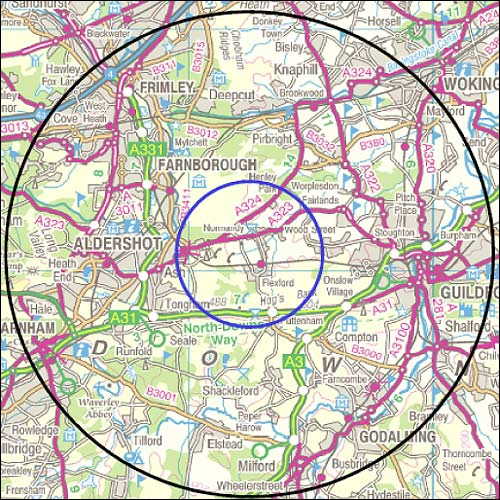
"Defra declared a 3km protection zone (blue) and 10km surveillance zone (black),
where nearby animals are monitored."
BBC Online, 4 August 2007
UK Foot And Mouth Disease Outbreak
Near FMD GM Vaccine Research Lab
www.nlpwessex.org/docs/fmdlab.htm
"Chief veterinary officer Debby
Reynolds has confirmed that the biosecurity arrangements at the Pirbright Laboratory are being investigated
as a possible source of the foot-and-mouth disease outbreak. At a Defra briefing at 3.15pm
today (Saturday), Mrs Reynolds said it was too early to favour any hypothesis of where the
disease might have come from over another. But she said: 'Pirbright has been asked to review its biosecurity arrangements.' The Institute of
Animal Health Pirbright
Laboratory, which carries out research into exotic diseases, including foot-and-mouth
disease, is approximately five miles away from the Surrey farm which is the site of the
outbreak..... Questioned about the possible introduction of a vaccination policy, Mrs
Reynolds said it was being considered and had been since day one."
Vet confirms Pirbright is under investigation
Farmers
Guardian, 4 August 2007
4 August 2007
New Prime Minister Gordon Brown and Environment Secretary Hilary Benn cut short their holidays in order to attend a meeting of the British government's crisis committee, COBRA, on Saturday (4 August) following an outbreak of Foot and Mouth Disease (FMD) in cattle in the UK. Mr Brown was informed of the outbreak at 7 pm on Friday.
The new outbreak, the first since 2001, is on a farm at Wanborough, Nr Guildford, Surrey, in the south of England.
The farm is a relatively short distance from the UK's leading Foot And Mouth research laboratory at the Institute of Animal Health, Pirbright (see map below). The government's Chief Veterinary Officer, Debby Reynolds, told the BBC Radio 4's PM programme on Saturday afternoon that the Institute is being considered as one of several potential sources for the current outbreak.
With the suddenly renewed focus on public policy in relation to the management of this highly contagious animal health disease, which occurs throughout much of the world, it is worth considering the following from our earlier bulletin of 10 September 2001:
"..... a paper submitted to the Journal of General Virology 31 October 2000 by UK government scientists from the Institute of Animal Health at Pirbright indicates that they had been working on a genetically engineered recombinant DNA vaccine [for FMD]. It is not clear if this might be instead of, or in addition to, the trials referred to by Dr Doyle, or possibly the same trials with a discrepancy over the vaccine type.
In the trials described in the journal in which pigs were challenged with live virus, the recombinant DNA vaccine only provided protection for some of the animals tested and 'was not as effective as conventional virus vaccine'. The paper also states: 'A particularly serious problem is that several outbreaks in Europe have been attributed to incomplete inactivation of the virus or to the escape of live virus from vaccine production laboratories'. The paper in fact makes passing reference to the UK outbreak [in 2001], because although the paper was originally submitted in October 2000 it was not accepted for publication (presumably with interim revisions required by the journal review panel) until 30 March 2001(http://www.sgm.ac.uk/JGVDirect/17505/17505ft.htm ).
It would certainly be regrettable if, in attempting to produce a new genetically engineered vaccine only a less effective type had been created, and in the process a foot-and-mouth virus had escaped into the environment - irrespective of whether the virus itself was naturally occurring or man made."
A wide range of interest groups, including the leading UK organic certification body the Soil Association, has long advocated vaccination as a primary control method for FMD outbreaks. However, awareness that such an approach is increasingly heading in the direction of genetically engineered options is not widespread.
Meanwhile, the affected farm for the new FMD outbreak is now subject to a 3km exclusion zone and a 10km surveillance zone. The Institute at Pirbright (post code location GU24 0NF) lies directly to the north of the outbreak site and falls within the 10km surveillance zone (see map).

"Defra declared a 3km protection zone (blue) and 10km
surveillance zone (black),
where nearby animals are monitored."
BBC Online, 4 August 2007
For more on this area of biotechnology (including the claim by former US veterinary consultant Dr Patricia Doyle that synthetic FMD vaccine trials had been going on in the UK in the months leading up to the 2001 outbreak) see our bulletin of 10 September 2001 "Losing Control of Global Biosecurity".
These issues are part of a growing broader concern about the inability to effectively control the biotech sector, particularly given the potentially lethal combination of radical genetic engineering techniques and human error.
It is not possible to ban the latter. So what about banning the former?
NLPWESSEX, natural law publishing
nlpwessex.org
"They wanted to make a contraceptive
vaccine by altering the genes of the mousepox virus. But in January the project gained
notoriety after the pair inadvertently created an unusually virulent strain of mousepox.
If a similar genetic manipulation were applied to smallpox, the scientists realized, this
feared killer could be made even more dangerous."
NLPWESSEX,
natural law publishing |